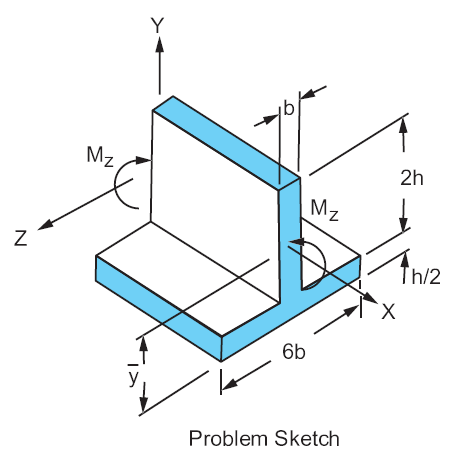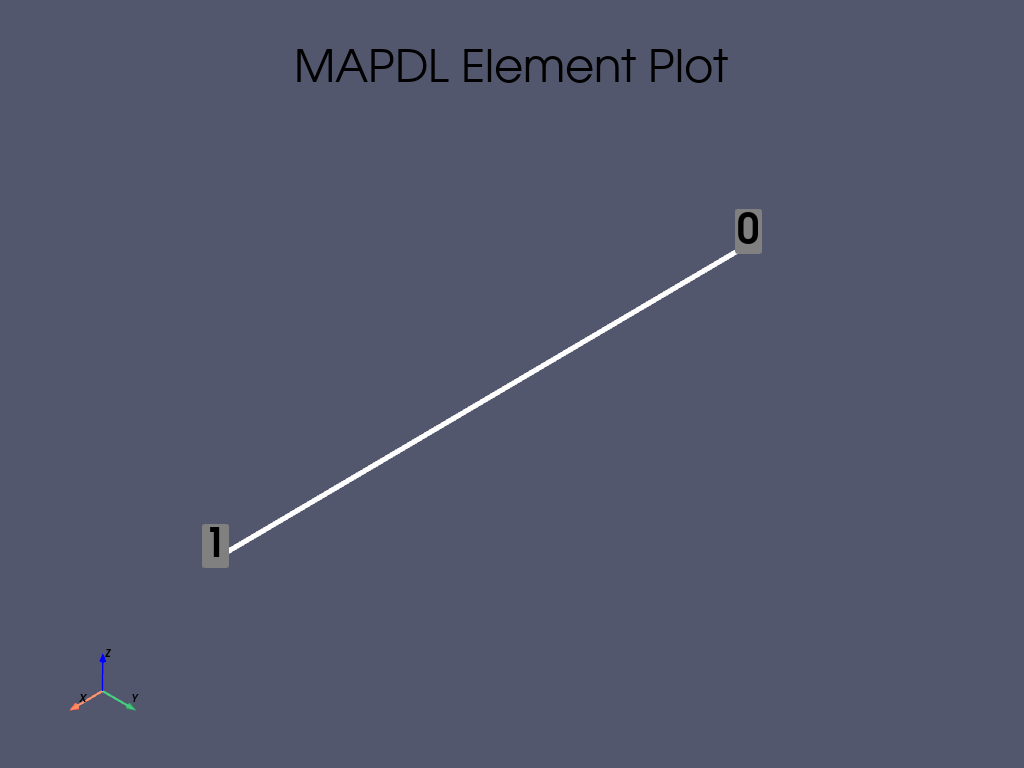Note
Go to the end to download the full example code.
Bending of a Tee-Shaped Beam#
- Problem description:
Find the maximum tensile \(\sigma_{\mathrm{(B,Bot)}}\) and compressive \(\sigma_{\mathrm{(B,Top)}}\) bending stresses in an unsymmetrical T-beam subjected to uniform bending \(M_z\), with dimensions and geometric properties as shown below.
- Reference:
S. H. Crandall, N. C. Dahl, An Introduction to the Mechanics of Solids, McGraw-Hill Book Co., Inc., New York, NY, 1959, pg. 294, ex. 7.2.
- Analysis Type(s):
Static Analysis (
ANTYPE = 0)
- Element Type(s):
3-D 2 Node Beam (
BEAM188)

Fig. 1 Figure 1: VM10 Geometry of Beam188 and Element Model#
- Material properties
\(E = 30 \cdot 10^6 psi\)
\(\nu = 0.3\)
- Geometric Properties:
\(l = 100\,in\)
\(h = 1.5\,in\)
\(b = 8\,in\)
- Loading:
\(M_z = 100,000\,in\,lb\)

- Analysis Assumptions and Modeling Notes:
A length \((l = 100 in)\) is arbitrarily selected since the bending moment is constant. A T-section beam is modeled using flange width \((6b)\), flange thickness \((\frac{h}{2})\), overall depth \((2h + \frac{h}{2})\), and stem thickness \((b)\), input using
Mapdl.secdata.
# sphinx_gallery_thumbnail_path = '_static/vm10_setup.png'
Start MAPDL#
Start MAPDL and import Numpy and Pandas libraries.
from ansys.mapdl.core import launch_mapdl
import numpy as np
import pandas as pd
# Start MAPDL.
mapdl = launch_mapdl()
Pre-processing#
Enter verification example mode and the pre-processing routine.
mapdl.clear()
mapdl.verify()
mapdl.prep7(mute=True)
Define element type#
Set up the element type BEAM188.
# Type of analysis: Static.
mapdl.antype("STATIC")
# Element type: BEAM188.
mapdl.et(1, "BEAM188")
# Special features are defined by keyoptions of BEAM188:
# KEYOPT(3)
# Shape functions along the length:
# Cubic
mapdl.keyopt(1, 3, 3) # Cubic shape function
# Print the list with currently defined element types.
print(mapdl.etlist())
LIST ELEMENT TYPES FROM 1 TO 1 BY 1
*****MAPDL VERIFICATION RUN ONLY*****
DO NOT USE RESULTS FOR PRODUCTION
ELEMENT TYPE 1 IS BEAM188 3-D 2-NODE BEAM
KEYOPT( 1- 6)= 0 0 3 0 0 0
KEYOPT( 7-12)= 0 0 0 0 0 0
KEYOPT(13-18)= 0 0 0 0 0 0
CURRENT NODAL DOF SET IS UX UY UZ ROTX ROTY ROTZ
THREE-DIMENSIONAL MODEL
Define material#
Set up the material, where:
\(E = 30 \cdot 10^6 psi\) - Young Modulus of steel.
\(\nu = 0.3\) - Poisson’s ratio.
# Steel material model.
# Define Young's moulus and Poisson ratio for steel.
mapdl.mp("EX", 1, 30e6)
mapdl.mp("PRXY", 1, 0.3)
# Print the list of material properties.
print(mapdl.mplist())
LIST MATERIALS 1 TO 1 BY 1
PROPERTY= ALL
MATERIAL NUMBER 1
TEMP EX
0.3000000E+08
TEMP PRXY
0.3000000
Define section#
Set up the cross-section properties for a beam elements, where:
\(w_1 = 6b = 6 \cdot 1.5 = 9\,in\) - flange width.
\(w_2 = 2h + h/2 = 2 \cdot 8 + 8/2 = 20\,in\) - overall depth.
\(t_1 = h/2 = 8/2 = 4\,in\) - flange thickness.
\(t_2 = b = 1.5\,in\) - stem thickness.
*****MAPDL VERIFICATION RUN ONLY*****
DO NOT USE RESULTS FOR PRODUCTION
LIST SECTION ID SETS 1 TO 1 BY 1
SECTION ID NUMBER: 1
BEAM SECTION SUBTYPE: T Section
BEAM SECTION NAME IS:
BEAM SECTION DATA SUMMARY:
Area = 60.000
Iyy = 2000.0
Iyz =-0.47962E-13
Izz = 247.50
Warping Constant = 673.35
Torsion Constant = 174.86
Centroid Y = 0.14433E-15
Centroid Z = 4.0000
Shear Center Y = 0.29551E-13
Shear Center Z = 0.30468
Shear Correction-xy = 0.54640
Shear Correction-yz = 0.55296E-14
Shear Correction-xz = 0.45475
Beam Section is offset to CENTROID of cross section
Define geometry#
Set up the nodes and elements. Create nodes between elements.
# Define nodes for the beam element.
mapdl.n(1, x=0, y=0)
mapdl.n(2, x=100, y=0)
# Define one node for the orientation of the beam T-section.
mapdl.n(3, x=0, y=1)
# Print the list of the created nodes.
print(mapdl.nlist())
LIST ALL SELECTED NODES. DSYS= 0
*****MAPDL VERIFICATION RUN ONLY*****
DO NOT USE RESULTS FOR PRODUCTION
NODE X Y Z THXY THYZ THZX
1 0.0000 0.0000 0.0000 0.00 0.00 0.00
2 100.00 0.0000 0.0000 0.00 0.00 0.00
3 0.0000 1.0000 0.0000 0.00 0.00 0.00
Define elements#
Create element between nodes 1 and 2 using node 3 as orientational node.
# Create element.
mapdl.e(1, 2, 3)
# Print the list of the elements and their attributes.
print(mapdl.elist())
# Display elements with their nodes numbers.
cpos = [
(162.20508123980457, 109.41124535475498, 112.95887397446565),
(50.0, 0.0, 0.0),
(-0.4135015240403764, -0.4134577015789461, 0.8112146563156641),
]
mapdl.eplot(show_node_numbering=True, line_width=5, cpos=cpos, font_size=40)

LIST ALL SELECTED ELEMENTS. (LIST NODES)
*****MAPDL VERIFICATION RUN ONLY*****
DO NOT USE RESULTS FOR PRODUCTION
ELEM MAT TYP REL ESY SEC NODES
1 1 1 1 0 1 1 2 3
[82, 87, 110]
Define boundary conditions#
Application of boundary conditions (BC).
mapdl.d(node=1, lab="ALL", mute=True)
mapdl.d(node="ALL", lab="UZ", lab2="ROTX", lab3="ROTY", mute=True)
Define distributed loads#
Apply a bending moment \(\mathrm{M_{z}}= 100000\,in\,lb\).
# Parametrization of the bending moment.
bending_mz = 100000
# Application of the surface load to the beam element.
mapdl.f(node=2, lab="MZ", value=bending_mz)
mapdl.finish(mute=True)
Solve#
Enter solution mode and run the simulation.
# Start solution procedure.
mapdl.slashsolu()
# Define the number of substeps to be taken this load step.
mapdl.nsubst(1)
mapdl.solve(mute=True)
Post-processing#
Enter post-processing.
# Enter the post-processing routine.
mapdl.post1(mute=True)
Getting displacements#
Using Mapdl.etable get the results of
the the maximum tensile and compressive bending stresses in
an unsymmetric T-beam with Mapdl.get_value.
# Create a table of element values for BEAM188.
mapdl.etable(lab="STRS_B", item="LS", comp=1)
mapdl.etable(lab="STRS_T", item="LS", comp=31)
# Get the value of the maximum compressive stress.
strss_top_compr = mapdl.get_value(
entity="ELEM", entnum=1, item1="ETAB", it1num="STRS_T"
)
# Get the value of the maximum tensile bending stress.
strss_bot_tens = mapdl.get_value(entity="ELEM", entnum=1, item1="ETAB", it1num="STRS_B")
Check results#
Finally we have the results of the the maximum tensile and compressive bending stresses, which can be compared with expected target values:
maximum tensile bending stress \(\sigma_{\mathrm{(B,Bot)}} = 300\,psi\).
maximum compressive bending stress \(\sigma_{\mathrm{(B,Top)}} = -700\,psi\).
For better representation of the results we can use pandas dataframe
with following settings below:
# Define the names of the rows.
row_names = [
"$$Stress - \sigma_{\mathrm{(B,Bot)}},\,psi$$",
"$$Stress - \sigma_{\mathrm{(B,Top)}},\,psi$$",
]
# Define the names of the columns.
col_names = ["Target", "Mechanical APDL", "RATIO"]
# Define the values of the target results.
target_res = np.asarray([300, -700])
# Create an array with outputs of the simulations.
simulation_res = np.asarray([strss_bot_tens, strss_top_compr])
# Identifying and filling corresponding columns.
main_columns = {
"Target": target_res,
"Mechanical APDL": simulation_res,
"Ratio": list(np.divide(simulation_res, target_res)),
}
# Create and fill the output dataframe with pandas.
df2 = pd.DataFrame(main_columns, index=row_names).round(1)
# Apply settings for the dataframe.
df2.head()
Stop MAPDL.
mapdl.exit()
Total running time of the script: (0 minutes 0.889 seconds)

